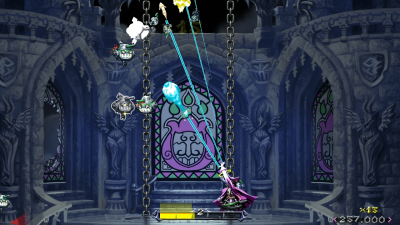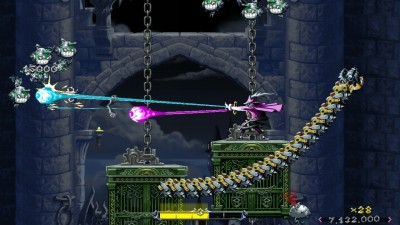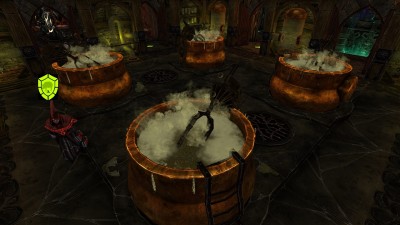Bonus Rounds are short, 5-minute musings on quirky titles that either end up hidden down the back of the sofa, or lost among the endless pile of Steam games and Bundles you own, but have never got around to playing. These could be reviews of PC, iOS or console games, Early Access titles, games made as part of a Game Jam, and so on. They’ll predominantly be games made by indie developers, and usually (but not always) published on a Sunday.
I purchased Savant-Ascent many months ago in one of those weekly indie bundles you see online. I’m a sucker for these deals and as a result own hundreds of games I’ve yet to play. Savant-Ascent stood out though, with its cool retro-pixel style and enticingly simple premise, it made me fire it up almost instantly. It’s a twin-stick shooter at heart, the twist being that you don’t have any freedom of movement aside from jumping between two ledges, whilst shooting and avoiding your enemies.
The visuals are purposely old-school. Pixel art is the name of the game here, and whilst the main character is animated well, the enemies are decidedly average and totally forgettable, unlike the wonderful designs seen in classics like Symphony of the Night and Super Metroid. During gameplay, this doesn’t really matter because you’re hurtling up that tower at such speed - everything around you becomes a delightfully-blurred twitch-fest. But fans of pixel art are sure to notice.
The soundtrack is worthy of a mention. In-game tracks are added as you collect power-ups in the form of CDs and can be played at will via the menu. They’re a heady mashup of chip-tune and dubstep, and would make a beatboxing Claptrap proud.
In order for any game like this to work, the controls have to be precise. Thankfully, DPad Studios nailed this part. It does feel a bit strange at first, not actually moving while shooting, but after a couple of quick deaths you soon pick it up. The downside to this simplicity is that there’s only so much pseudo-stationary shooting you can make interesting. When I started up Savant-Ascent again for the purposes of this review, after a long absence, I noticed that I’d only clocked 33 minutes play time on Steam – and within that time I’d completed the story and seen everything the game had to offer. That was before the Void update. After this review, and having wiped my previous save game to play through it fully again, I’d clocked a total of four hours. Most of that extra time can be attributed to the DLC, but by some miracle Savant-Ascent never manages to feel as brief as it actually is. God knows how they managed it, but Passtech somehow crafted a game that is incredibly short, but still feels like an epic journey.
But despite this, there’s no getting away from the problem that as an experience, Savant-Ascent is over too soon. You’ll progress a little, die a little, collect and use the power-ups a little, then, it’s gone. The Void update adds one extra level, a new power-up and a new boss. What isn’t immediately apparent, and leads to untold and unnecessary frustration, is that there’s no way you can complete this new level until you gain the new power – while providing no explanation on how to obtain that last power. Once this is realized however, there’s some fun to be had in collecting the parts to the final CD and completing the final level. But unfortunately it serves only to bring you face-to-face with one of the cheapest, most frustrating bosses a videogame can throw at you.
Yes, including Street Fighter IV’s Seth.
It was more difficult writing this Bonus Round Review than I thought it would be. My initial memory of Savant-Ascent the first time around was of fondness: a quirky, fun arcade title that was over way too soon. I pitched it a couple of weeks ago when I came up with the idea for this series, and when my idea of covering Savant-Ascent was accepted, I was looking forward to writing it. But returning to it and experiencing the new DLC left me with a slightly bitter aftertaste.
In a few months a second DLC pack is planned to be released, and I can only hope that it will put right the mistakes of the Void update and allow this little gem of a game to realize its full potential. As it stands, Savant-Ascent is currently one of those many indie games that come to within touching distance of successfully evoking classic gaming experiences, but manage to trip up at the last hurdle. The atmosphere is there, the setting is there, and it maintains that fine balance between homage and innovation. But it lacks the special something to make it truly worthwhile.
Still, at a low price and provided you go into it knowing what to expect, it’s worth a playthrough. Savant-Ascent is clearly a labor of love from a passionate developer with a deep understanding of what makes its inspirations work. It’s just a shame that knowledge didn’t quite make it into the final game.




